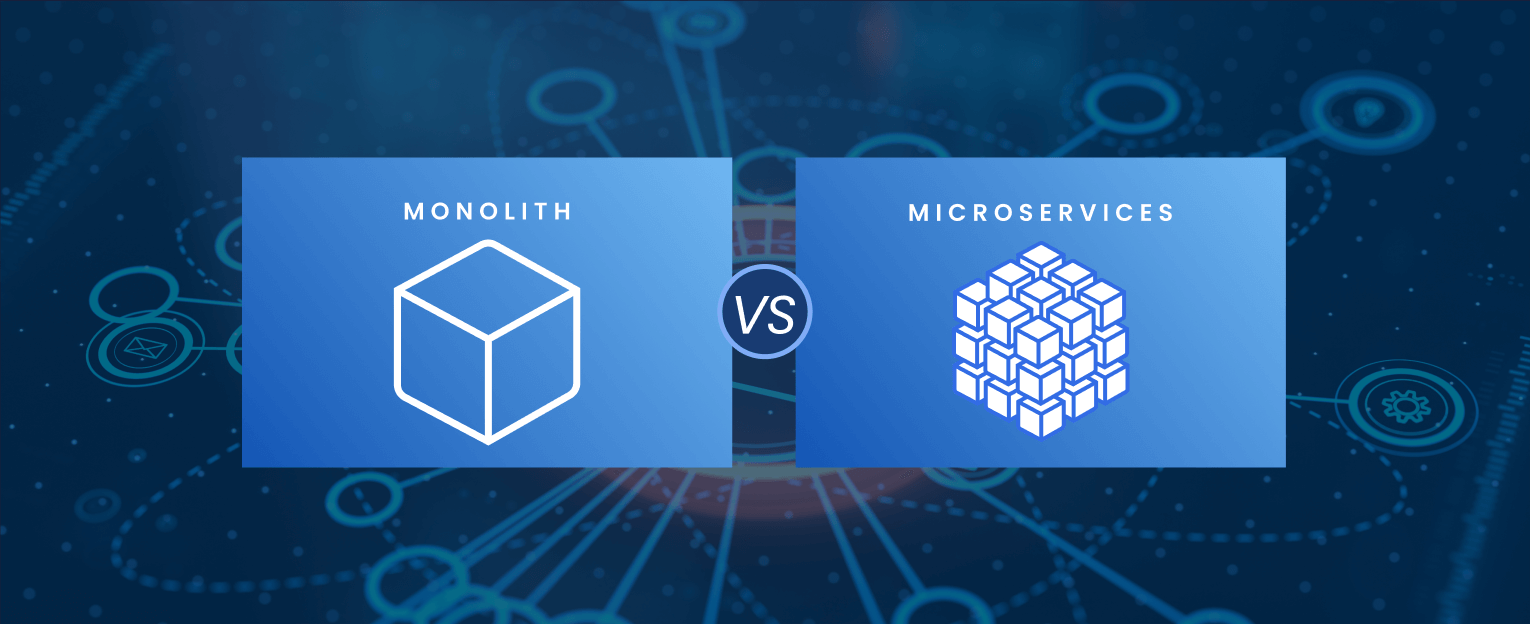In recent years, the debate between Microservices vs Monolith architecture has garnered much attention. After all, choosing the right architecture for your business technology stack can significantly impact the efficiency and scalability of your operations.
Learn about infrastructure migration with DevOps in our detailed article that delves into the differences, benefits, and drawbacks of both architectures.
In 2009, Netflix struggled to meet the skyrocketing demand for its video streaming services. Its existing infrastructure was struggling so much that it decided to migrate from on-premise infrastructure to cloud (IT infrastructure from private data centers to a public cloud).
Ultimately, it aligned with a shift from a monolithic architecture to microservices.
What makes this transition intriguing is that, in 2009, the term “microservices” was not mainstream, making Netflix one of the first to adopt and implement this architecture.
Today, Netflix’s strategy has evolved, with over a thousand microservices overseeing various platform components.
Their code deployment pace is equally impressive, sometimes with thousands of daily updates.
Their shift from a monolithic architecture to a microservices framework is a compelling example in the ongoing architectural approach debate for businesses.
Choosing microservice vs. monolith design for your business depends on the stage of your business. Still confused? Let’s discuss these factors in detail and evaluate which architectural fit is best for your business needs.
What Is the Difference Between Monolithic and Microservices System Design?
Monolithic and Microservices are two contrasting architectural approaches in system design, each with its own set of characteristics and advantages. Choosing between a monolithic vs. microservices system design is not a simple black-or-white decision.
Rather, it involves considering various aspects of your business, such as your business goals, your team’s experience, and the nature and scale of your project, among other things.
Each approach has scenarios where it might be more advantageous. Therefore, understanding these contexts can guide you toward the most beneficial decision.
What is a Monolithic Architecture?
Monolithic architecture refers to a software design in which all components of the application are tightly integrated into a single, self-contained structure.
During the early stages of development, this approach can simplify the process. The architecture uses a uniform technology stack throughout the application, which limits flexibility.
Learn more about Web Application Architecture trends and best practices in 2024.
Deployment of the application occurs as a single unit, and while scaling (horizontal vs vertical) is possible, it can be expensive as all components scale together, potentially leading to inefficiencies.
While monolithic architecture has both advantages and challenges, it is essential to carefully consider its suitability for specific project requirements. Monolithic architectures are advantageous for simpler, smaller projects, offering quick development and simplicity.
However, they face challenges as projects grow in size, including limited scalability, maintenance complexity, and a lack of flexibility for diverse technology stacks and team independence.
Advantages of Monolithic Architecture
Monolithic architecture facilitates rapid development and time-to-market services, as all components act as a single application. This streamlines the development life cycle, enabling developers to iterate and deploy quickly.
Monolithic architecture requires fewer resources for deployment compared to microservices, making it a cost-effective choice, especially for projects with limited resources.
The architecture also simplifies the testing and debugging processes. With all components integrated into a single application, testing becomes more straightforward, allowing for efficient identification and resolution of issues during the development phase.
One notable usage of monolithic architecture is its utilization of a stable technology stack. The entire application operates on a single stack, ensuring uniformity and ease of maintenance.
This approach can be especially advantageous when integrating tightly coupled components, such as MLOps solutions, where centralized control and consistency are critical for managing machine learning workflows effectively.
Disadvantages of Monolithic Architecture
One major drawback of monolithic architecture is its limited scalability when dealing with larger systems.
While simplicity can be useful in the development of smaller projects, scaling up the system to meet larger, more complex requirements can pose challenges.
Initially, the monolithic architecture facilitates faster development, but as the system grows, it becomes more complex to maintain.
The ease of rapid development may lead to difficulties in managing and maintaining a larger codebase, thus impacting the speed of subsequent development cycles.
Monolithic architecture faces challenges regarding technology stack diversity, as the single technology stack may create difficulties in adapting to evolving technological needs.
Testing within a monolithic architecture can also be challenging, as the tight integration within the monolith makes it difficult to test individual components independently.
While a stable technology stack characterizes monolithic architecture, it comes at the cost of reduced fault tolerance and isolation.
A failure in one component can have a cascading effect on the entire system, potentially compromising its stability and reliability.
What Are Microservices?
On the contrary, Microservices adopt a modular and decentralized approach. Microservices architecture consists of independent services, each representing a specific business capability.
This design involves breaking down an application into smaller, independent services that communicate through well-defined interfaces.
Each microservice handles a specific function, allowing for more flexibility, scalability, and ease of maintenance. Changes or updates to one microservice don’t necessarily impact the entire system.
The integration in this architecture is achieved through loosely coupled, well-defined interfaces.
The development of a microservices-based system can be complex, involving the creation and management of multiple services. However, easier maintenance of smaller, self-contained services offset this complexity.
The technology stack in a microservices architecture is flexible, permitting the use of different technologies for various services based on their unique requirements.
Updates are isolated to specific services, allowing for independent development and deployment cycles. Fault isolation is a notable feature, ensuring that failures are confined to individual services, maintaining the overall system’s robustness.
Advantages of Microservices
A microservices architecture offers numerous advantages. It excels in scalability, allowing each service to scale independently, enabling organizations to allocate resources based on specific service demands, and improving system performance.
The architecture’s flexibility is evident in its diverse technology stack for each service. It fosters innovation and can adapt to various functional requirements.
Maintenance is simplified with independent updates for each service, reducing complexities. It associates updates across a monolithic application.
The architecture promotes team independence, enabling faster innovation to work on different services and contributing to more efficient development cycles.
Disadvantages of Microservices
In microservices, dealing with multiple services introduces operational complexity, making it difficult to manage diverse components.
The complex nature of this can result in heightened operational burdens. The flexibility of having a diverse technology stack for each service comes at the cost of increased resource consumption.
It’s crucial to consider the trade-offs between flexibility and resource efficiency carefully. However, the complexity of end-to-end testing and monitoring processes counterbalances.
These complexities can complicate the identification and resolution of issues that may span across multiple services. Microservices architecture faces hurdles in terms of inter-service communication where team independence encourages innovation.
Despite that, it demands a robust infrastructure and expertise to manage the complexities of numerous independent services effectively.
When Should You Use Microservices vs Monolith Architecture?
As we have established, the choice between microservices vs monolithic architecture depends largely on the specific needs and circumstances of a business.
Let’s cover examples of when each type of architecture is more suitable so you can better understand which one fits your needs.
Monolithic architecture often outshines in scenarios involving small to medium-sized projects, like a local restaurant’s website or a personal blog that values simplicity.
It also presents a more cost-effective solution for smaller businesses with limited resources, such as a local retail shop’s inventory management system.
The speed of development and market entry offered by monolithic models make them a preferred choice for startups aiming to quickly launch an MVP.
While comparing monolith vs. microservices architecture for businesses operating with a single development team, managing a monolithic application, like a small consulting firm’s client management system, proves to be more efficient compared to the latter.
On the other hand, microservices architecture shines when dealing with large, complex systems that necessitate scaling, such as Amazon’s e-commerce platform.
It allows for independent development, deployment, and scaling of each function, like the product catalog, payment processing, and recommendation engine.
The architecture’s flexibility when differentiating between microservices vs monolith architecture to accommodate diverse technologies lets each service employ the most suitable tech stack.
For example, a media company might choose Python for its content recommendation engine and Java for its payment system.
Furthermore, microservices support team autonomy, which is beneficial when multiple teams work on different application parts.
Now that we have discussed monoliths vs. microservices, you can choose the most suitable infrastructure to support your application. Learn how to optimize your business operations further by employing DevOps best practices.
Wrap Up: Which Is Better, Monolithic or Microservices?
To summarize, the choice between microservices vs monolith architecture depends on various factors. These factors include specific business needs, scale, growth expectations, team structure, technology requirements, and budget constraints.
It’s not a one-size-fits-all decision, and the ideal solution may even involve a combination of both architectures, known as a “hybrid” approach.
This hybrid approach aims to strike the right balance between simplicity and scalability, offering the best of both worlds. Selecting the appropriate architecture, whether monolith or microservices, is crucial for your business.
It directly impacts your operational efficiency, scalability, and growth potential. Making the right decision in this regard is paramount. Fortunately, you don’t have to navigate this complex decision-making process alone.
Our team of professionals is here to guide you through the process and implement the most suitable solution for your business needs. With their expertise and experience, they can help you find the architecture that best aligns with your business goals and objectives.
Don’t hesitate to contact our migration experts today for a complimentary consultation. They will provide valuable insights and recommendations to help you make an informed decision and set your business on the path to success.














